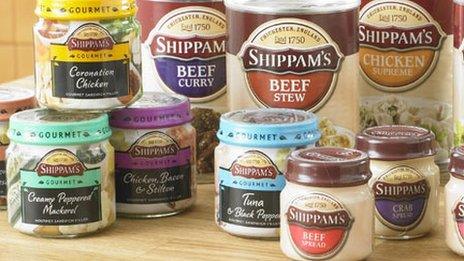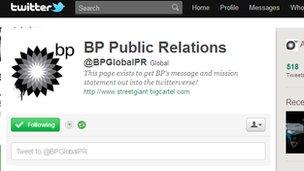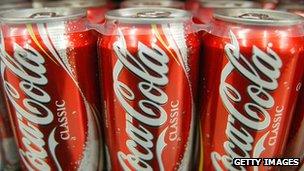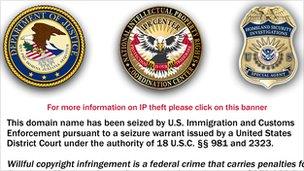Copy and #paste: How brandjacking stalks companies online
- Published

Discussing the vast range of Shippam's Paste formed a lot of Ben's 'engagement' on Twitter
Many businesses spend thousands, some even millions, presenting their brands online.
Twitter, Facebook and - in the past week - Google Plus are all places where firms flock with hopes of engaging with their customers, making them feel wanted and looked after.
The collective social media efforts of image-conscious companies will be the culmination of much head-bashing from some of the finest minds in advertising.
Yet they'll never be as good as Ben.
Ben is 18 years old. What he lacks in intelligence he makes up for in enthusiasm, and is always looking to build on his rather empty CV in the hope of going to university.
Through his network of contacts - possibly his mother - he managed to get a job as the social media intern for Shippam's Paste, external, a manufacturer of low-cost sandwich spreads, which have graced many a school lunchbox over the years.
He eagerly set up the company's first Twitter account - @ShippamsPaste, external - and immediately began engaging with customers.
It worked. Ben was so talented and so effective that within three weeks Shippam's Paste had amassed more than 7,000 followers. Ben's boss, Paul, swiftly promoted him to social media executive intern. Ben and his followers were thrilled.
Ben would take to Twitter to engage ("whats your favourite shippams paste! retweet it to me!"), share tales of life in the Shippam's office ("pauls got a keyring that makes spooky noises its really annoying it goes wooo") and even offer advice ("theres no vegetarian pastes sorry but why not try the crab spread its only crabs").
In short, Ben was a marketing force to be reckoned with. Customers who had previously forgotten Shippam's even existed were not only buying paste, but taking pictures of themselves and letting Ben know.

Many took to Twitter to express their love of 'Ben'
Ben was also completely fictitious. And absolutely nothing to do with Shippam's.
But to dwell on that is to miss the point. Everyone knew he wasn't real, but his persona was so endearing that people simply didn't care.
#paste
Last week came the news Ben's followers had been dreading: "Account suspended".
The fans were up in arms, and calls for a boycott were only marginally tongue-in-cheek. Shippam's just didn't get it, fans complained, and soon #paste trended across the UK.
"We definitely got the joke," insists Paul Smith, a spokesperson for Shippam's.
"I know people will miss Ben. He really touched a chord with people."
Mr Smith says at first they weren't quite sure how to react. Indeed, for a while they wondered if Ben actually was a plucky intern, stowed away in an office somewhere within the company.
When they were sure it was not a member of their staff they got in touch with Twitter and, soon enough, Ben was no more.

BP says it has not taken any action against social media accounts posing as the company
"The guy that was running it was very funny," Mr Smith said.
"But if you have someone impersonating your brand and claiming to be an employee it's a problem.
"I think in that sense it's not that we want to control it, but that it's just not in our control. You don't know where it's going to go, or if the tweets were going to suddenly change.
"We did have calls and email about it asking if it was us and whether we endorsed it. There's not many brands that would allow that to continue."
Shippam's' problem was one that faces many major brands. While Ben was utterly harmless, other companies aren't always that lucky.
googlesucks.com
Brandjacking - meaning simply to hijack a brand - ranges from humorous accounts like the lovable Ben right up to sophisticated fraud programs that lose companies millions in sales and has terrible effects on reputation.
MarkMonitor, a firm that researches instances of brandjacking as well as offering services to counteract it, estimated in a recent report that in the hotel industry alone 580 million visits a year are being diverted away from legitimate sites by brandjackers.
This equates, MarkMonitor says, to around $2bn (£1.3bn) a year in potential lost revenue.
In a separate study, MarkMonitor found that traffic to fake sites claiming to sell luxury brands reaches approximately 120 million visitors per year, which, to give it context, is around half of the traffic the actual companies attract.
The techniques are relatively simple. Handbag.com, for example, fell victim to a counterfeit site named handbagcom.com. The fake site's makers would buy advertising on popular search engines and rely on the victim not glancing up at the false URL which, even with a quick glance, is easily passable.
"They're not always fraud," explains Charlie Abrahams from MarkMonitor.

Fans of Coke set up their own Facebook page for the brand - and ended up as Coca-Cola employees
"They're quite often just what's called pay-per-click and are just trying to generate traffic.
"A very large proportion of searches on the internet are for brand names. People buy domain names that have well-known brands in them. The domain owner is getting 1p per click-through or something like that, but he's illegally using the brand owner's name to generate the traffic."
His advice is to try to get there first. If there is an obvious variation to the official brand's URL then companies should buy it. Likewise, social media accounts are there for the taking and if brands are too slow, policies are in place to regain control, external if they prove it's rightfully theirs.
Domains are trickier. Take Google, for example. Aside from the geographical variations of Google.com, they also own gewgol.com, goolgel.com, glogoo.com, gmale.com and many others.
Never ones to miss a trick, the company has also bagged googlesucks.com and other even less pleasant addresses.
In some cases, brandjackers are far more open about their intentions.
In the wake of the BP Gulf of Mexico oil spill, environmental campaigners unleashed a sea of brandjacking in the name of activism.
On Twitter, an account named @BPGlobalPR regularly sends out lines such as "let's be honest, we don't really NEED oysters" to its 150,000-plus following.
BP said that while it was aware of such Twitter accounts it has not yet taken any action, saying that it is clear these accounts are not run by BP and are therefore not having any detrimental effect.
They say that far more pressing on their brandjacking radar is employment fraud.
Over the past few years, many websites and email accounts have regularly claimed to be offering jobs at the company and, like many internet scams, request cash and identity information so potential employees can be registered.
A spokeswoman for BP said that in some cases the con has gone so far that people have got in touch with the company to ask how soon they can start now the registration fees have been paid.
"That's our main concern with brandjacking: it's organised crime.
"We do make every effort to track down perpetrators, but it's extremely difficult as these are highly-organised operations."
Missed chance
That the word brandjacking can encompass both organised criminal gangs and a friendly made-up boy named Ben goes some way to explaining the depth of the problem brands face.
The man behind @BPGlobalPR, who goes by the name of Leroy Stick, makes no excuses for making BP's life difficult.
"You can spend all sorts of time and money trying to manufacture public opinion," he wrote on tech news site Gizmodo, external. "But ultimately, that's up to the public, now isn't it?"
Armando Alves, a leading authority on social media marketing, said that as well as facing significant challenges in identifying brandjackers, firms also face a difficult dilemma when figuring out how to deal with popular brandjacks.
"Twitter and Facebook have strict policies regarding brand abuse, but from my experience some brands turn what could be seen as a lack of control into a brand asset," he said, citing Coca-Cola who, after discovering a fan-made page on Facebook had gained an audience of 2 million, opted to keep the page open and hire the people responsible.

Brandjacking sites selling fraudulent goods in the US are replaced with this take-down notice
He believes parodies should be largely left alone, but if companies feel they must step in, it is important not to look like spoilsports.
"They could end it gracefully, otherwise that's a missed chance. The person doing it could be invited to do other brand initiatives."
Whether or not Shippam's Ben will be seen as a missed chance remains to be seen.
After a day of what can only be described as uproar, Twitter reopened the @ShippamsPaste account. Ben was back, but only for a fleeting moment, tweeting: "good bye it was fun but ive got to stop now because of problems".
Ben's creator Ed Jefferson, a London-based account manager, said he never imagined the profile would last as long as it did.
"I thought it would be quite funny to run a company Twitter deliberately incompetently," he said in an email.
"Shippam's fish paste just seemed quite funny as a phrase as much as anything, and it seemed at the same time unlikely that they'd have a Twitter account and just on the edge of possibility that they'd unwittingly let someone in the office do it for them."
Shippam's say they have no immediate plans to launch an official Twitter feed and so, for now, their Twitter presence sits still, leaving Ben's fans to forever wonder if he ever plucked up the courage to talk to the girl in the chip shop, external.